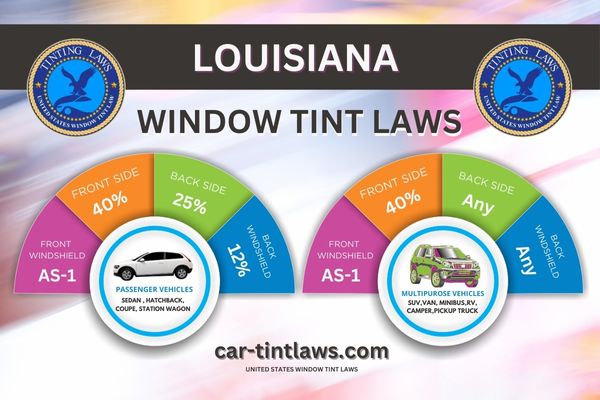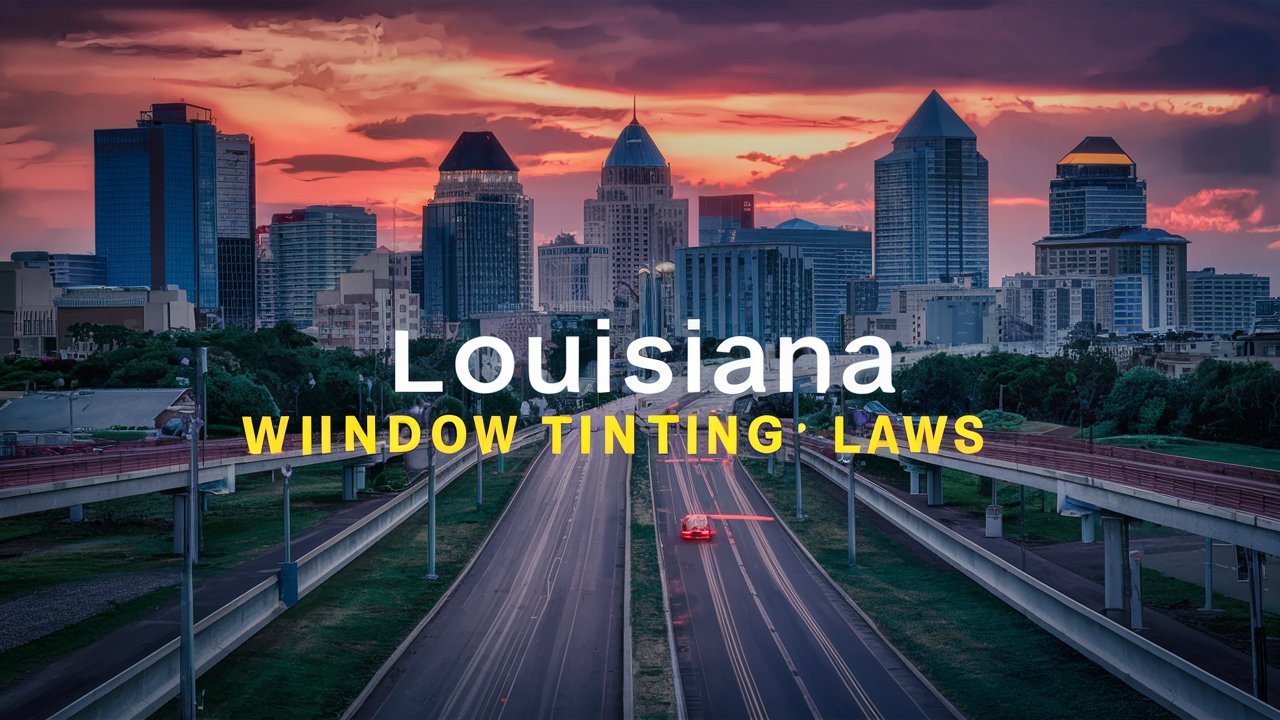You might not be aware that Louisiana’s window tinting laws differ considerably depending on the type of vehicle you drive.
For example, sedans have more stringent regulations on front side window tinting compared to SUVs and vans. But, did you know reflective tints are completely off-limits?
Moreover, there are specific rules about compliance stickers and even medical exemptions that can alter what’s allowed.
The repercussions of not following these guidelines can be quite expensive. Curious about how these regulations could affect you and your vehicle?
Let’s delve into the intricacies of these laws to make sure you’re fully informed.
Window Tint Darkness in Louisiana
When it comes to tint darkness in Louisiana, you need to know that for sedans, the front side windows must allow more than 40% of light in, while the rear side and rear windows can be any darkness.
For SUVs and vans, the front side windows have the same 40% requirement, but the rear side and rear windows also have no darkness restrictions.
Understanding these rules is essential to guarantee your vehicle complies with state regulations and to avoid fines and penalties.
Tint darkness for sedans:
In Louisiana, sedans must adhere to specific tint darkness limits to ensure road safety and legality.
As per Louisiana State window tint laws, the tint regulations for sedans are as follows:
- Windshield: Non-reflective tint is permitted on the top 5 inches of the windshield.
- Front Side windows: Must allow more than 40% of light in.
- Back Side windows: Must allow more than 25% of light in.
- Rear Window: Must allow more than 12% of light in.
Additionally, non-reflective tint above the AS-1 line or the top 5 inches of the front windshield is acceptable.
Remember, reflective tint is prohibited on sedan windows in Louisiana to prevent glare and ensure clear visibility.
To comply with the law, ensure your tint darkness meets these specified limits.
Following these guidelines is crucial for passing inspections, avoiding penalties, and driving safely and legally.
Tint darkness for SUV and Vans:
- Windshield: Non-reflective tint is allowed on the top 6 inches of the windshield.
- Front Side windows: Must allow more than 40% of light in.
- Back Side windows: Any shade can be used.
- Rear window: Any shade can be used.
Window Tint Reflection in Louisiana
In Louisiana, reflective window tint is prohibited for all vehicles, including sedans, SUVs, and vans, to guarantee excellent visibility and road safety.
Reflective tint can cause glare and obstruct visibility for both the driver and other motorists.
Instead, Louisiana allows non-reflective window tint within specific Visible Light Transmission (VLT) limits, maintaining a balance between privacy and safety.
Tint reflection for sedans:
- Front Side windows: Reflective tint is strictly prohibited to ensure clear visibility and road safety.
- Back Side windows: Reflective tint is strictly prohibited to ensure clear visibility and road safety.
Tint reflection for SUV and vans:
- Back Side windows and Rear window: Any darkness of tint is allowed, but reflective tint must be less than 20% for all windows.
- Reflective tint: Must not exceed 20% reflectivity on any window of your SUV or van.
Other Louisiana window tint rules and regulations
- Side Mirrors: No restrictions.
- Restricted Colors: In Louisiana, all tint colors are permitted.
- Certificates: Manufacturers of film need to certify the film they sell in the state. Make sure your dealer is using certified film.
- Stickers: A sticker or label of compliance to identify legal tinting is required between the film and glass on each tinted window.
- Medical Exceptions: Louisiana allows medical exemptions for special tint with certification from a licensed physician. The state’s Visible Light Transmission (VLT) requirements must still be met.
- Penalties: Failure to comply with Louisiana tint regulations can result in fines issued by the Louisiana State Police. The fines vary depending on the severity of the violation.

Medical Exemptions for Window Tint Rules in Louisiana
If you suffer from conditions like albinism, lupus, porphyria, or photophobia, you can qualify for a medical exemption from Louisiana’s window tinting laws.
These medical exemptions allow you to use a different level of visible light transmission than typically allowed.
To get this exemption, a licensed physician must provide a certification specifying the level of light transmission needed for your tinted windows.
This certification must be kept in your vehicle at all times.
Law enforcement officers may request to see your medical certification during traffic stops to confirm your exemption.
This verification process guarantees that only those with authentic medical needs benefit from these exceptions.
Without a medical exemption, all car windows must follow Louisiana’s tinting laws, which include specific percentages for visible light transmission.
These rules are in place to guarantee that law enforcement can see inside vehicles for safety and security reasons.
Louisiana Laws – RS 32:361.2 – Medical exemption
Louisiana Window Tint Medical Exemption Affidavit (.pdf file)
Louisiana Window Tint Ticket Cost
Getting caught with illegal window tint in Louisiana can set you back anywhere from $150 to $250 in fines.
Louisiana window tint laws are strict, and noncompliance can lead to significant financial penalties.
The window tint ticket cost depends on the severity of the violation, and repeated offenses can result in higher fines.
Adhering to these regulations not only helps you avoid fines but also the legal consequences that come with breaking the law.
If you’re caught with illegal tint, you might face a citation, and your vehicle could be subjected to further inspection.
This adds to the inconvenience and potential costs you could incur.
Understanding Louisiana window tint laws is vital for avoiding these penalties.
You should make sure your vehicle’s window tint meets the state’s specific requirements.
By doing so, you’ll save yourself from the hassle and expense of dealing with fines and legal consequences.
Staying informed about the regulations and ensuring your vehicle’s compliance can go a long way in keeping you on the right side of the law and maintaining harmony with your community.
Louisiana Demographics Overview
When considering Louisiana’s window tinting laws, it’s helpful to understand the state’s demographics.
Louisiana has a population density of about 107 people per square mile, and its residents are diverse, including White, Black, Hispanic, and Asian groups.
With a median age of around 36 years, Louisiana’s demographics also reflect a mix of age groups.
Population Density Stats
Louisiana, with its diverse blend of urban and rural areas, boasts a population density of approximately 107 individuals per square mile.
This state has a total population of over 4.6 million residents, creating a unique mix of communities.
Concerning population density, New Orleans stands out as the most densely populated city, showcasing its lively urban life.
Baton Rouge, the state capital, also plays a significant role in Louisiana‘s overall density, with around 2,982 individuals per square mile.
The state’s population distribution highlights the balance between vibrant cities and peaceful rural landscapes.
While New Orleans and Baton Rouge serve as the major urban hubs, many other regions in Louisiana maintain a more laid-back, lower-density setting.
This variety allows for a diverse lifestyle, where one can savor the conveniences of city life or the serenity of the countryside.
Understanding Louisiana’s population density is essential for various aspects of living,
including complying with window tinting laws. The urban areas may have different considerations compared to rural ones due to the density and lifestyle variances.
This demographic insight guarantees that you can make informed choices, whether you’re in New Orleans, Baton Rouge, or any other part of Louisiana.
Cultural Diversity Insights
Embrace the vibrant cultural mosaic that defines Louisiana, where a rich blend of racial and ethnic backgrounds create a unique and dynamic community.
The state’s population is approximately 59.6% White, 32.9% Black or African American, and 6% Hispanic or Latino.
This cultural diversity is the heart of Louisiana, influencing everything from music and cuisine to festivals and daily life.
Louisiana’s heritage, rich with French, Spanish, African, and Native American traditions, shines through in its cultural landscape.
New Orleans, the state’s largest city, epitomizes this multicultural atmosphere, with a mix of French, African, and Caribbean influences.
Celebrations like Mardi Gras and the widespread appreciation for Cajun and Creole cuisine are prime examples of how these diverse traditions are interwoven into Louisiana’s identity.
This rich cultural diversity also manifests in the state’s religious affiliations, with a significant mix of Catholic, Protestant, and other faith traditions.
Understanding these cultural dynamics is essential when considering local laws, including car window tinting regulations.
Louisiana’s window tinting laws reflect a community that values both tradition and modernity, ensuring that vehicle modifications, like car window tinting, meet both safety standards and cultural expectations.
Age Group Distribution
Louisiana’s age group distribution highlights a median age of around 36 years, showcasing a relatively young population compared to the national average.
This diverse population is characterized by a notable proportion of individuals under the age of 18, making up approximately 23%, while those over the age of 65 constitute about 15%.
These figures indicate that Louisiana has a balanced demographic spread with a significant number of young individuals and a growing number of elderly residents.
The largest age group in Louisiana encompasses adults aged 18 to 64, underscoring a workforce ready to contribute to the state’s economy and community activities.
This demographic composition is essential for various aspects of life, including the implementation and adherence to window tinting laws, as it affects the preferences and needs of vehicle owners.
Over the years, demographic trends in Louisiana have shown a gradual aging of the population, reflecting broader national patterns.
However, the state’s median age remains relatively young.
Understanding this age group distribution is essential for policymakers and residents alike, as it influences everything from educational initiatives to healthcare services, ensuring that the diverse needs of Louisiana’s population are met.
References
Frequently Asked Questions
What’s the Darkest Legal Tint in Louisiana?
The darkest legal tint for your front side windows is 40% VLT. These regulations address safety concerns and visual impairment.
For your rear windows, there aren’t any legal limits on tint darkness, ensuring you follow the law.
What Medical Conditions Qualify for Window Tint in Louisiana?
Imagine your car as a protective shield. For those with glaucoma, skin conditions, or light sensitivity, a tint exemption is vital.
Louisiana allows exemptions for albinism, lupus, porphyria, and photophobia, providing essential UV protection.
What State Has the Darkest Tint Law?
When comparing states, Vermont has the darkest tint law, allowing only 24% VLT for all vehicle types.
Knowing this prevents legal consequences and helps you understand tinting exemptions better, ensuring you comply with state guidelines.
What Is the Darkest Window Tint?
The darkest window tint offers privacy and customization options, but balancing tint darkness with visibility is key.
Consider benefits and drawbacks, and remember legal limits and enforcement guarantee safety. Choosing wisely helps you belong and stay compliant.
Conclusion
Understanding and following Louisiana’s window tinting laws is essential to avoid fines and guarantee safety.
Just as the rule of law maintains order in society, these regulations guarantee that vehicle windows permit adequate light transmission, prohibit reflective tints, and require compliance stickers.
Remember, medical exemptions are available with proper documentation.
By adhering to these guidelines, you contribute to a safer driving environment and demonstrate respect for state regulations, much like adhering to any other established societal norms.
